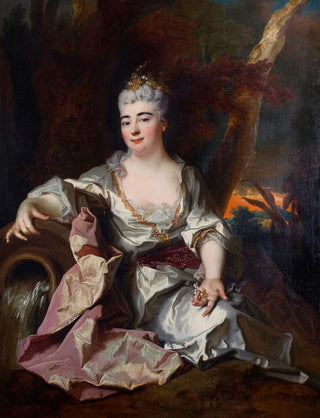Art print | Portrait of Marie-Louise-Élisabeth d'Orléans, Duchess of Berry 1695-1719 - Nicolas de Largillière


View from behind

Frame (optional)
Portrait of Marie-Louise-Élisabeth d'Orléans, Duchess of Berry 1695-1719 - Nicolas de Largillière – Captivating Introduction
In the rich and complex landscape of 18th-century French art, the portrait of Marie-Louise-Élisabeth d'Orléans, Duchess of Berry, painted by Nicolas de Largillière, stands out for its majesty and elegance. This artwork, emblematic of an era when court painting reached its zenith, offers a fascinating glimpse into aristocratic life and the aesthetic values of its time. Largillière, a master of the portrait, succeeds in capturing not only the physical features of his subject but also the very essence of her personality. The piece thus becomes a living testament to the social and political dynamics of Old Regime France, while showcasing the technical skill of its creator.
Style and uniqueness of the work
Largillière's style is characterized by meticulous attention to detail and a subtle use of color. In the portrait of the Duchess of Berry, the sumptuous drapery of her gown, highlighted with touches of light, contrasts with the dark background, emphasizing the central figure. The delicate nuances of the skin and the rendering of her hair, both shiny and flowing, demonstrate an exceptional mastery of pictorial technique. This portrait is not merely a simple representation; it embodies a visual narration where every element, from the choice of accessories to facial expressions, contributes to constructing an idealized image of nobility. The Duchess's posture, both graceful and commanding, reinforces her status, while her gaze, imbued with dignity, seems to invite the viewer to reflect on her life and role within the court.
The artist and his influence
Nicolas de Largillière, born in 1656, is one of the most prominent portraitists of his time. His career, marked by a deep understanding of aristocratic representation codes, allows him to build a reputation that transcends the borders of France. Influenced by the great masters of Flemish painting, he manages to incorporate elements of this tradition while developing

Matte finish

View from behind

Frame (optional)
Portrait of Marie-Louise-Élisabeth d'Orléans, Duchess of Berry 1695-1719 - Nicolas de Largillière – Captivating Introduction
In the rich and complex landscape of 18th-century French art, the portrait of Marie-Louise-Élisabeth d'Orléans, Duchess of Berry, painted by Nicolas de Largillière, stands out for its majesty and elegance. This artwork, emblematic of an era when court painting reached its zenith, offers a fascinating glimpse into aristocratic life and the aesthetic values of its time. Largillière, a master of the portrait, succeeds in capturing not only the physical features of his subject but also the very essence of her personality. The piece thus becomes a living testament to the social and political dynamics of Old Regime France, while showcasing the technical skill of its creator.
Style and uniqueness of the work
Largillière's style is characterized by meticulous attention to detail and a subtle use of color. In the portrait of the Duchess of Berry, the sumptuous drapery of her gown, highlighted with touches of light, contrasts with the dark background, emphasizing the central figure. The delicate nuances of the skin and the rendering of her hair, both shiny and flowing, demonstrate an exceptional mastery of pictorial technique. This portrait is not merely a simple representation; it embodies a visual narration where every element, from the choice of accessories to facial expressions, contributes to constructing an idealized image of nobility. The Duchess's posture, both graceful and commanding, reinforces her status, while her gaze, imbued with dignity, seems to invite the viewer to reflect on her life and role within the court.
The artist and his influence
Nicolas de Largillière, born in 1656, is one of the most prominent portraitists of his time. His career, marked by a deep understanding of aristocratic representation codes, allows him to build a reputation that transcends the borders of France. Influenced by the great masters of Flemish painting, he manages to incorporate elements of this tradition while developing






